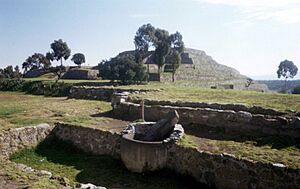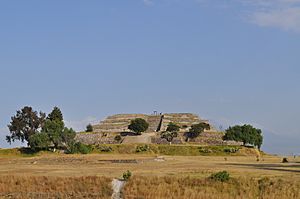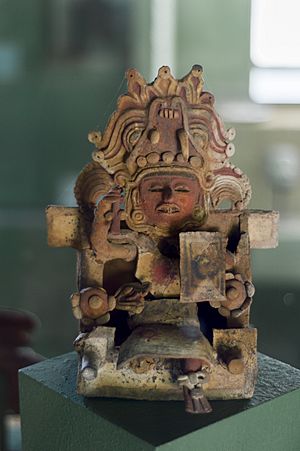Xochitecatl facts for kids
Xochitecatl is an ancient site in Tlaxcala, Mexico. It's about 18 kilometers (11 miles) southwest of Tlaxcala city. This special place was built a very long time ago, mostly between 1000 and 400 BC. People continued to use it, with some breaks, until around 950 AD. Even after that, people still visited for important ceremonies. The ruins cover an area of 12 hectares (about 30 acres) on top of a small, old volcano.
Unlike many other ancient cities, Xochitecatl wasn't a big city itself. Instead, it was a special place for ceremonies and rituals. People lived in the areas around it and came to Xochitecatl for important events.
Contents
What Does the Name Mean?
The name Xochitecatl comes from two words in the Nahuatl language. Xōchitl means "flower," and tecatl means "person." So, Xochitecatl means "the person of flowers" or "the lineage of flowers."
Where is Xochitecatl?
Xochitecatl is built on top of an old, extinct volcano. This volcano is about 4 kilometers (2.5 miles) wide and rises about 200 meters (650 feet) above the valley floor. From Xochitecatl, you can see amazing views of other volcanoes like Popocatépetl, Iztaccihuatl, and La Malinche.
Two rivers, the Atoyac and Zahuapan, flow near the site. This area is very good for farming because the land between the rivers is so fertile. Some people even call it "the Mesoamerican Mesopotamia" because it's so rich in agriculture.
Xochitecatl is also very close to another important ancient site called Cacaxtla. Cacaxtla is famous for its beautiful painted murals. Xochitecatl is only about 1 kilometer (0.6 miles) west of Cacaxtla.
History of Xochitecatl
Early Times (Preclassic Period)
Around 800 BC, people started building Xochitecatl. The first big structures were the Pyramid of Flowers, the Spiral Building, and the Serpent Building. Over the next few centuries, more parts were added to these buildings.
By 350 BC, Xochitecatl became the main center for a powerful group of people who controlled a large part of western Tlaxcala. The Pyramid of Flowers was made much bigger around 200 BC. But then, around 150 AD, the site was left empty. This happened after a volcano called Popocatepetl erupted.
Later Times (Epiclassic Period)
Between 600 AD and 950 AD, people came back to Xochitecatl. It became a smaller ceremonial center within the larger city area of Cacaxtla. During this time, the Platform of the Volcanoes was built. The Pyramid of Flowers became a very important place for rituals, including the sacrifice of children.
Around 950 AD, both Xochitecatl and Cacaxtla were abandoned again. However, there is proof that people still came to Xochitecatl for ceremonies even after it was mostly empty.
Modern Discoveries
In 1993 and 1994, archaeologists led by Mari Carmen Serra Puche started digging at Xochitecatl. They wanted to learn more about the main buildings. During their work, they found two workshops where people used to make tools from obsidian, a type of volcanic glass. These workshops were in the Pyramid of Flowers and the Serpent Building.
Exploring the Site
The main ceremonial area of Xochitecatl has two large open spaces, or plazas. The most important buildings are found around these plazas. The Pyramid of Flowers, the Serpent Building, and the Platform of the Volcanoes are around the main plaza. The Spiral Building is next to the western plaza.
The Pyramid of Flowers
(Pirámide de las Flores in Spanish, also called Building E1)
This huge pyramid was built during the Preclassic Period, but people used it for a very long time, even after the Spanish arrived. The base of the pyramid is about 100 meters (328 feet) by 140 meters (459 feet). That's similar in size to the Pyramid of the Moon in Teotihuacan!
Inside the pyramid, archaeologists found the remains of more than 30 children and one adult. They also found special offerings with them. Some children had green stone beads placed in their mouths. This was believed to help them on their journey to the underworld.
On the stairway leading up the pyramid, over 2000 clay figurines and 15 stone sculptures were found. Many of the clay figurines show women of all ages, from babies to old women. Some show women who are pregnant or carrying babies. These figurines are very detailed and show what people wore long ago. Some women wear decorated skirts or blouses called quezquemetl. Others have colorful bows or flowers in their hair.
At the base of the pyramid's stairway, there are two large stone basins. One is 1.7 meters (5.6 feet) wide! Inside the larger basin, four sculptures were found: a toad, a mythological snake with a human face coming out of its mouth, and two human faces.
During the digs, over 200 obsidian spear points and many pieces of obsidian were found. More than 20 stone sculptures were also discovered, but many were broken. These include animals like a dog, an amphibian, and a monkey. There are also sculptures of people and mythical creatures. One sculpture shows a human face with a rattlesnake body. Experts think this might be linked to a local story about a goddess named Xochitl, who can change from a beautiful woman into a snake.
Every year on September 29, the sun rises perfectly from the mouth of the La Malinche volcano when seen from the top of the Pyramid of Flowers. This date is also when a festival happens at a nearby town.
The Serpent Building
(Edificio de la Serpiente in Spanish, also called Building E2)
This building was built around 700 BC. It is 80 meters (262 feet) long and 50 meters (164 feet) wide. On top of it, there is a large stone basin. Inside this basin, a broken stone slab was found with carvings of a snake's fangs and a forked tongue.
To the north of the basin, two stone sculptures were found. One shows a man dressed as a jaguar. The other shows a man with a large forehead and lips, holding a staff. A room was built on the west side of the Serpent Building. Many obsidian tools and pieces were found in this room, suggesting it was a workshop. Things like knife blades, spear points, and scrapers were found here.
The Serpent Building was first a square shape with a stairway on the north side. Later, it was made bigger to the east. The old stairway was blocked, and a new one was built.
The Spiral Building
(Edificio de la Espiral in Spanish, also called Building E3)
This round, stepped pyramid is on the western side of the ceremonial center. It was built around 700 BC. Because it's on a hillside, the western side has more levels than the eastern side. Inside, archaeologists found no rooms, only volcanic ash. This building doesn't have a regular stairway. People climbed it by following its spiral shape.
In 1632 AD, about 90 years after the Spanish arrived, a Christian cross was placed on top of this building. It is still there today. Two burials were found inside. This building was probably a temple dedicated to Ehecatl, the god of wind.
The Platform of the Volcanoes
(Basamento de los Volcanes in Spanish, also called Building E4)
This structure is in the middle of the main plaza and faces north–south. It is 50 meters (164 feet) long and 35 meters (115 feet) wide. It was first built in the Middle Preclassic period and then reused later.
In the 1960s, a German archaeologist found over 200 female figurines in this building. One very interesting figurine showed a goddess named Tlazolteotl, who was connected to earth and new life.
The earliest part of this building was made from a type of volcanic soil covered with mud. Later, the old stone walls were covered with a smooth plaster. Like at Teotihuacan, this building is angled about 16 degrees away from magnetic north. Evidence of special offerings, possibly including young children, was found in the upper part of this platform.
Xochitecatl is cared for by the Instituto Nacional de Antropología e Historia (National Institute of Anthropology and History) and is open for people to visit.
See also
 In Spanish: Xochitécatl para niños
In Spanish: Xochitécatl para niños




